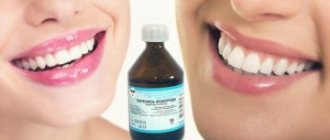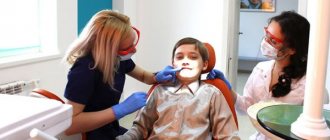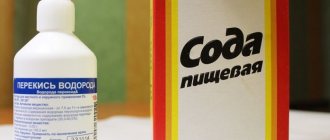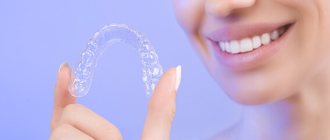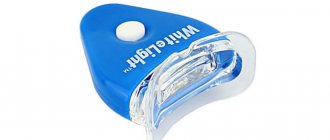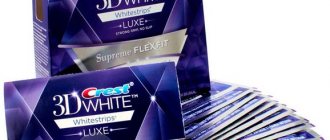Every person dreams of smiling and conquering those around him with his snow-white smile. In modern conditions, there are a huge number of options for whitening teeth. And here it is important not to make a mistake with the choice. After all, you want the chosen method to be safe, effective and relatively inexpensive. And with all this, the result would be noticeable on the same day. In this article we will tell you about the different methods of teeth whitening and their features, and what questions patients most often ask before this procedure.
Whiten your teeth yourself
You can whiten your teeth at home without involving dentists in this process. Pharmacies have a huge selection of products that can completely whiten your teeth. The whole secret lies in hydrogen peroxide (or urea), which is an essential component of all whitening products.
Whitening gels, strips, and pencils are actively sold. Their use does not require special skills and they are very easy to apply. Such remedies act quite quickly. In addition, they are very convenient to use - you can take them to work or on a trip; You can go about your business and whiten your teeth at the same time. The results of gel products can be seen after just a few uses. The tone of the teeth can be lightened by 3-4 points, and the result usually lasts for a year.
The most popular brands of such products are Plus White, ROCS, Crest.
There are also at-home systems for teeth whitening. They are very similar to the technique used by dentists. The complex includes peroxide gel, mouthguard and activating lamp. With the help of such systems, teeth can be lightened by 4-5 tones, and the result lasts up to one and a half years. The most famous systems are Zoom, Opalescence.
Contraindications
Despite the effectiveness and widespread use of this method, there are several limitations to its use. It cannot be used when:
- pregnancy and breastfeeding;
- the presence of acute intracavitary diseases in a chronic form;
- periodontal diseases;
- dental hyperesthesia (increased sensitivity) to changes in temperature (from low to high);
- thinning the enamel;
- a large number of fillings placed;
- malignant tumors;
- carious lesion;
- use of crowns and braces;
- general diseases: endocrine pathologies, asthma, hypertension;
- visually discernible loss of enamel associated with age-related or pathological changes.
Important: age is a special limitation. Whitening enamel using this method is prohibited for children and adolescents under 16 years of age.
All these cases are contraindications to the use of peroxide, either as a stand-alone drug or as part of other products.
A quick way to whiten your teeth
The development of dentistry has reached a high level and makes it possible to restore the whiteness of enamel quite quickly.
Toothpastes and rinses will allow you to achieve the desired result within a few weeks or months. Hydrogen peroxide-based preparations will make your smile radiant within a month with regular use.
Semi-professional home systems give results within a week with daily use. Today you can find products that promise to restore the whiteness of your enamel in one evening.
But the fastest and most effective are professional methods used by dentists. In one hour with a doctor, tooth enamel can be lightened by 8-12 shades at once, without any risk to health.
Are folk remedies effective in teeth whitening?
There are several folk methods that, even at the modern level of medical development, are quite actively used. All of them are available in price and method of application.
- Hydrogen peroxide. Sold in any pharmacy. Peroxide oxidizes the organic matrix under the enamel and thus brightens it. The essence of the method is as follows: after brushing your teeth, you need to treat the enamel surface with a 3% peroxide solution. This can be done with a clean napkin, cloth or cotton pad. This must be done extremely carefully, since if peroxide gets on the gums or mucous membranes, a burn may occur. This method cannot be used for a long time and often, since in addition to the coloring pigment, the top layer of enamel is also destroyed. Be extremely careful not to swallow the peroxide.
- Baking soda. Make a thick soda solution, apply it to the brush and brush your teeth as usual. You can add more salt to the solution. The procedure can be performed once a week.
- Tea tree oil. Perfectly restores and strengthens gums, reduces the amount of plaque. In the evening, after hygienic teeth cleaning, apply a few drops of oil to the brush and massage the teeth for several minutes. This method will maintain the white tint of the enamel. The procedure is recommended to be carried out 1-2 times a week.
Many people argue about the effectiveness of folk remedies for teeth whitening, but they do exist. Dentists are skeptical about such methods and recommend using special products.
Advantages and disadvantages
The method has both advantages and some disadvantages. Benefits include :
- Availability.
- Efficiency.
Among the disadvantages are:
- The presence of a large number of contraindications.
- High probability of enamel injury.
Contraindications
The use of this drug is contraindicated in the following cases :
- Diseases of the oral cavity occurring in the acute stage.
- Caries, periodontal disease.
- Presence of braces or other orthodontic systems.
- Weak enamel.
- Age up to 12 years.
In the absence of the listed contraindications, it is still advisable to consult a dentist and carry out the procedure only with his consent.
Whitening teeth in dentistry
In their practice, dentists use modern, effective and safe teeth whitening techniques.
The reactive oxygen species that is released when gels are activated is the basis of almost all modern teeth whitening technologies. To increase the effect of the gels, the process is carried out under the radiation of halogen, LED or ultraviolet lamps (zoom 4).
The main benefits of teeth whitening at the dentist are:
- Speed of the procedure. The average duration is no more than an hour.
- High efficiency. In one session, tooth enamel can become 12 shades lighter.
- Duration of wear. With proper care, the result of a snow-white smile lasts up to 5-7 years.
- Safety of the procedure. The doctor carefully monitors the entire process and minimizes possible damage to health in all possible ways.
But there are also a number of disadvantages (or inconveniences) that a patient may experience during professional tooth enamel whitening:
- Staying in one position for a long period of time. This may not be to everyone's liking.
- The risk of developing enamel sensitivity increases.
- For several days you will have to abstain from coffee, strong tea and other colored foods and drinks. You will need to minimize the number of cigarettes you smoke or give them up completely.
- Dentures and fillings should not be bleached. In this regard, they may need to be replaced.
The latest advancement in professional whitening is laser whitening. This is a quick and gentle way to whiten enamel. The patient experiences minimal discomfort, and the risk of getting a burn is reduced to zero, since the procedure does not heat the tissue. The laser quickly penetrates the enamel without drying it out. In addition, the radiation from the laser compacts the enamel. However, the cost of this procedure is very high.
Dentists' opinion
Doctors do not express strong protests against teeth whitening with peroxide. They agree that the procedure is effective. Moreover, similar methods are used for whitening in the dentist’s office, for example, lightening the enamel and removing plaque using carbamide peroxide (15% or diluted 35%). The principle is the same: oxidation occurs on the surface of the enamel, due to which the required whiteness is achieved. Bacteria are cleaned off and plaque disappears.
But here lies the secret: in the dentist’s office, the whitening procedure is not only about ridding the patient of soft tartar and changing the shade of the enamel. The doctor also uses pastes aimed at remineralizing teeth. This way the integrity of the enamel is preserved and caries is prevented.
There is only one way to carry out remineralization at home: brush your teeth with fluoride paste. However, this is not enough to completely restore the damaged layer. This is where the danger lies.
If you decide to lighten your teeth with peroxide, do it very carefully and as little as possible. Visit your doctor's office first and have your tooth decay treated.
Is it possible to whiten artificial teeth?
Patients who have ceramic and plastic dentures are often concerned about the possibility of changing the color of the dentures. Hydrogen peroxide can only act on organic compounds. Therefore, artificial teeth cannot be whitened using conventional methods.
The best option would be the following sequence of actions:
- teeth whitening,
- installation of prostheses.
Otherwise, the artificial teeth will need to be replaced with new ones to match the new shade of the remaining teeth.
Extended teeth and fillings can also be whitened. If the patient nevertheless decides to undergo whitening, then new fillings will need to be installed. This is especially true in visible areas of the dentition.
Hydrogen peroxide - what is this substance?
Hydrogen peroxide, or peroxide, is a colorless liquid with a faint metallic taste. The substance is used as an antiseptic - oxygen molecules destroy any infection. Having a cleansing and disinfecting effect, peroxide does not accelerate wound healing. When disinfecting cuts or abrasions, tissue cells are damaged, which prolongs the regeneration period and leads to the formation of scars on the skin.
Due to its oxidizing properties, the liquid is used as a bleach in the textile and pulp and paper industries and as a catalyst in chemical production.
A highly concentrated solution when taken orally causes burns to the mucous membranes, respiratory tract and even death!
Interesting!
Hydrogen peroxide in aquariums is used to “revive” fish. During long-term transportation, the aquarium overheats or the filtering equipment is turned off, the fish experience oxygen starvation and suffocate. Adding a few drops of the substance per liter of water will bring them back to life.
What method is effective for whitening teeth for a smoker?
Yellow teeth often accompany people who have a bad habit such as smoking. And the fangs suffer the most from this habit; it is they that receive the maximum dose of nicotine.
Smokers are recommended to use a special tooth powder to clean their teeth. Thanks to its abrasive properties, it is able to remove even heavy plaque from tooth enamel. In order to prevent damage to tooth enamel, this method is recommended to be performed once a week.
Special toothpastes are designed to maintain regular oral hygiene to maintain the whiteness of teeth. They contain enzymes that help break down plaque. The most popular pastes of this type are:
- ROCS "Antitobacco"
- Rembrandt "Antitobacco"
- Astera for smokers.
Before teeth whitening at the dentist, smokers are recommended to undergo a professional teeth cleaning procedure, due to which the whitening will be more uniform and active.
How to whiten tetracycline teeth?
Tooth enamel can change its color while taking tetracycline antibiotics. Teeth may become dirty yellow, brown, or dark gray. Children's teeth during the period of formation and taking antibiotics of this type are especially susceptible to color changes. It is quite difficult to whiten such teeth, since the coloring pigment is located quite deep. No home remedies or techniques will bring results. The only way out in this case is to go to the dentist and get professional whitening. In addition, there is a high probability that several procedures will be required.
Effect on enamel
What is a raid? These are bacteria and food debris that were not removed in a timely manner. First, a soft plaque appears, which then turns into tartar. This is already a solid formation, inaccessible to any means of influence at home. But you can remove soft plaque yourself using various means:
- Activated carbon;
- lemon juice;
- soda solution;
- iodine;
- hydrogen peroxide.
Peroxide ranks first among home remedies in terms of effectiveness. It reacts with plaque formed on the surface of the enamel and removes it. A chemical process of oxidation occurs, resulting in the formation of oxygen. It destroys the elements of soft plaque. This way you can clean and whiten your teeth.
Whitening teeth under braces
Teeth with braces require special care. If the patient neglected the doctor’s recommendations, drank a lot of strong coffee or tea, then the teeth become unsightly and acquire a yellowish tint. It is better not to whiten your teeth before removing braces, because most of the tooth is under the structure. As a result, after removing braces, dark spots may form on the teeth, because... Lightening gels are not included in the design. In addition, wearing braces is stressful for tooth enamel, which endures a lot of stress. She becomes more sensitive and vulnerable. Therefore, those who wear braces have teeth that are more prone to decay. Dentists recommend postponing the whitening procedure until the system is removed.
The only sure thing for people wearing braces is to visit a dental hygienist regularly to have their teeth cleaned. This procedure will help get rid of yellow plaque.
When to expect the effect
You won't get instant results. If you use peroxide regularly, you will notice the first effect after 5–7 days. The maximum result is noticeable after 14 days of using the method. Your teeth will become 1–2 shades lighter.
But be careful! If the result inspires you, you can start using peroxide often, but this has dire consequences:
- thinning of enamel;
- caries;
- loss of teeth.
You can whiten your teeth with home remedies such as baking soda and peroxide, lemon juice, and salt no more than 4 times a year. Otherwise, the result will be unhappy, because for all their effectiveness, the products are aggressive and, if used for a long time or incorrectly, damage the enamel.
How do stars whiten their teeth?
A smile is the calling card of many celebrities. It is she who determines the overall impression, the appearance of a person, and, possibly, potential success. Therefore, celebrities do not skimp on dental procedures and invest a lot of money in their snow-white teeth. The stars use only the latest and proven methods of professional tooth enamel whitening.
Teeth whitening isn't everything. To maintain the result, you need to periodically clean your teeth enamel and use only special high-quality pastes for everyday oral care.
If you want to become the owner of a beautiful smile, do not experiment with products. The best option would be to see a specialist. After all, in order to choose the right whitening method, you need to correctly assess the condition of the oral cavity, teeth, the original color of the enamel and the desired result. If you decide to whiten your teeth at home, strictly follow the instructions and do not violate the whitening technology. Otherwise, you may harm your health and get negative results.
Important to pay attention
In order to whiten your teeth with hydrogen peroxide as safely as possible, you must follow the following recommendations:
- Do not use a solution with a concentration higher than 3%. This is fraught with serious burns of the mucous membranes and irreversible destruction of the enamel.
- If you experience the slightest discomfort, discomfort or burning sensation, you must immediately stop the procedure and rinse your mouth thoroughly with clean water.
- You should refrain from bleaching enamel with peroxide if there are unhealed wounds, cracks or ulcers in your mouth.
- For bleaching, you should use a fresh solution of hydrogen peroxide, since it quickly loses its active properties when exposed to air.
- A prerequisite before the first whitening procedure is to check for possible allergic reactions.
